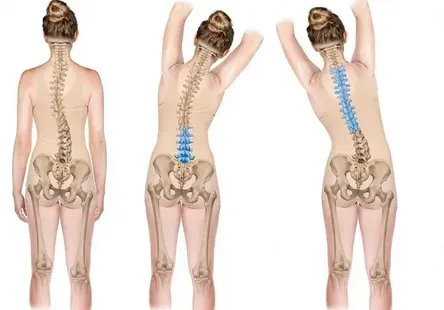Lumbar lateral shift Vs. Scoliosis

Introduction
Sciatic scoliosis, also known as sciatic scoliotic list (SSL) [Matsui H, et al. 1998; Krishnan KM, and Newey ML. 2001], trunk list [Gillan MG, et al. 1998], or trunk shift [Wu W, et al. 2019], is acknowledged as a nonstructural scoliosis reactive to nerve root irritation. It is observed in 13.2–17.7% of adults with lumbar disc herniation (LDH) [Kim R, et al. 2015; Zhang Y, et al. 2019; Gillan MG, et al. 1998].
A lumbar lateral shift can occur in different ways:
Ipsilateral shift – leaning toward the painful side.
•Contralateral shift – leaning away from the painful side (more common) [McKenzie RA. 1972; Tenhula JA, et al. 1990; Matsui H, et al. 1998].
•Alternating scoliosis – shifting between both sides, also referred to as alternating lumbar lateral shift [Capener N. 1933; Peterson S, and Laslett M. 2020].
This shift occurs as a reaction to spinal nerve compression or irritation, which may be due to muscle spasms or postural compensation [Weitz EM. 1976; Falconer MA, et al. 1948; Grieve GP. 1983; White AA, and Panjabi MM. 1990].
Causes of a Lumbar Lateral Shift
Two primary theories explain the direction of the shift:
1. Finneson’s Theory [Akhaddar A. 2023; Matsui H, et al. 1998]:
• Laterally herniated discs → shift away from pain.
• Medially herniated discs → shift toward pain.
2. Disc Mechanics Theory [Porter RW, and Miller CG. 1986; McKenzie RA. 1972]:
• Disc herniation pushes the trunk away.
• Vertebral collapse shifts the trunk toward pain.
Sciatic scoliosis is strongly associated with intervertebral disc pathology [Suk KS, et al. 2001]. Unlike idiopathic scoliosis, sciatic scoliosis is temporary and resolves when the underlying cause is treated.
Identifying a Lumbar Lateral Shift
McKenzie’s (1981) criteria for diagnosing a lateral shift include [Tenhula JA, et al. 1990]:
• A noticeable upper body shift.
• The shift occurs alongside back pain.
• The patient cannot voluntarily correct their posture.
• Restricted or painful side-bending.
• Symptoms change when attempting to correct the shift.
A side-bending test is used to confirm both the presence and direction of the shift.
Precautions in Treatment
Physiotherapists must be cautious when correcting a lateral shift. Treatment should be stopped immediately if [Laslett M. 2009]:
• Pain worsens or spreads.
• Nerve symptoms appear (e.g., numbness, weakness, bowel/bladder dysfunction).
• The trunk cannot realign despite repeated attempts.
• The patient experiences dizziness or nausea, requiring gentler methods.
If correction is not possible, alternative treatments should be explored instead of forceful realignment.
Differentiating Sciatic Scoliosis from Idiopathic Scoliosis
A key distinction between sciatic scoliosis (lumbar lateral shift) and idiopathic scoliosis is vertebral rotation.
• Idiopathic scoliosis is a structural condition with a persistent spinal curve and visible vertebral rotation on X-rays. It develops gradually and may progress over time [K.-L. Hsu et al. 2012].
• Sciatic scoliosis (lumbar lateral shift) is a temporary postural adaptation due to pain or nerve irritation, such as a herniated disc. It does not involve vertebral rotation and usually resolves when the underlying nerve issue is addressed [Pinto FC, et al. 2002].
When painful scoliosis is present in adolescents or young adults, clinicians should investigate potential underlying causes, such as disc herniation, spondylolisthesis, or tumors [Afshani E, Kuhn JP. 1991; Pneumaticos SG, Esses SI. 2003; Burke NG, et al. 2011].
Conclusion
Understanding sciatic scoliosis vs. idiopathic scoliosis is crucial for accurate diagnosis and treatment:
• Sciatic scoliosis is a temporary postural shift due to nerve irritation.
• Idiopathic scoliosis is a structural spinal deformity with vertebral rotation.
• Physiotherapy should focus on treating the root cause, not forcing alignment.
By identifying a lumbar lateral shift early, healthcare professionals can avoid unnecessary interventions and focus on effective pain relief.
References
•Akhaddar, A. (2023). Atlas of Sciatica: Etiologies, Diagnosis, and Management. Springer.
•Burke, N. G., Walsh, J., McEvoy, S., Heffernan, E., & Dudeney, S. (2011). Scoliosis secondary to a rib haemangioma. Joint Bone Spine, 78, 527.
•Capener, N. (1933). Alternating Sciatic Scoliosis. Proceedings of the Royal Society of Medicine, 26(4), 425-429. PMID: 19989147.
• Falconer, M. A., McGeorge, M., & Begg, A. C. (1948). Surgery of lumbar intervertebral disk protrusion; a study of principles and results based upon 100 consecutive cases submitted to operation. British Journal of Surgery, 35(139), 225-249. doi: 10.1002/bjs.18003513902.
•Gillan, M. G., Ross, J. C., McLean, I. P., & Porter, R. W. (1998). The natural history of trunk list, its associated disability and the influence of McKenzie management. European Spine Journal, 7(6), 480-483. doi: 10.1007/s005860050111.
•Hsu, K., Tai, T., Chien, J., & Lin, C. J. (2012). Sciatic scoliosis: An easily misdiagnosed disease in adolescents and young adults. Tzu Chi Medical Journal, 24(4), 196-200.
•Kim, R., Kim, R. H., Kim, C. H., Choi, Y., Hong, H. S., Park, S. B., Yang, S. H., Kim, S. M., & Chung, C. K. (2015). The incidence and risk factors for lumbar or sciatic scoliosis in lumbar disc herniation and the outcomes after percutaneous endoscopic discectomy. Pain Physician, 18(6), 555-564. PMID: 26606007.
•Krishnan, K. M., & Newey, M. L. (2001). Lumbar scoliosis is associated with a disc herniation in an adult. Rheumatology (Oxford), 40(12), 1427-1428. doi: 10.1093/rheumatology/40.12.1427.
•Laslett, M. (2009). Manual correction of an acute lumbar lateral shift: Maintenance of correction and rehabilitation: A case report with video. Journal of Manual & Manipulative Therapy, 17(2), 78-85. doi: 10.1179/106698109790824749.
•Matsui, H., Ohmori, K., Kanamori, M., Ishihara, H., & Tsuji, H. (1998). Significance of sciatic scoliotic list in operated patients with lumbar disc herniation. Spine (Phila Pa 1976), 23(3), 338-342. doi: 10.1097/00007632-199802010-00010.
•McKenzie, R. A. (1972). Manual correction of sciatic scoliosis. New Zealand Medical Journal.
Made By
Abdelrahmen Taha
PT, MSc
Esraa elghanem
Specialized in spinal deformities, Certified by ISST Schroth
Subscribe our newsletter
Get exclusive content directly to your inbox every week 😄
Your e-mail address





